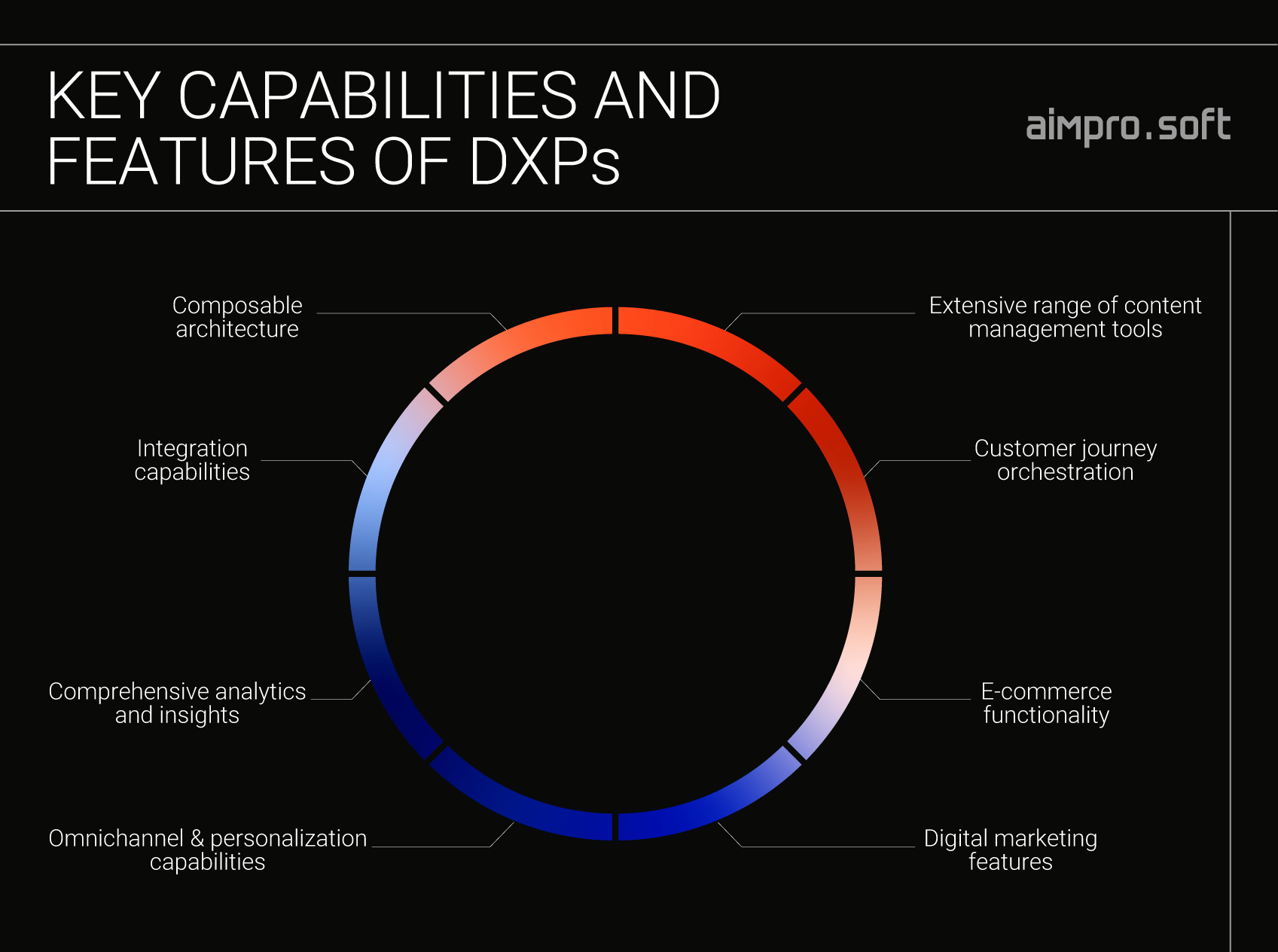What Is a Digital Experience Platform, and Why Does Your Business Need One?

Key takeaways
- From the limited capabilities of traditional CMS systems to an integrated set of technologies based on a centralized platform. Understand the essence of modern DXP systems and key layers that compose the architecture of modern DXP platforms, and find out what a DXP system is not.
- Composable architecture, tools for content management, integration capabilities, and comprehensive analytics are only part of the extensive functionality that DXP offers. Find out core DXP features and capabilities to make informed decisions that align with your business goal and meet your requirements.
- Learn the main benefits of DXP platforms that will help you recognize their potential impact on improving operational efficiency, providing control over each touchpoint, and enhancing customer engagement and retention.
- Find out cases when DXP isn’t the right solution for your business. The insights will help you understand why investing in DXP adoption isn’t beneficial for your specific organizational needs and scale, and avoid unnecessary risks.
Let’s imagine two different scenarios: the one that you most likely find yourself in now and the other one that is seemingly utopian for now but highly probable with the right DXP.
Your marketing team is juggling multiple tools for managing your digital presence. Customer data is scattered across different systems, making it nearly impossible to get a unified view of your customers. Every time you launch a new campaign, you spend more time troubleshooting integration issues than engaging with your customers. Your website and social media channels each tell a slightly different story because they’re managed in silos. Personalization is a buzzword you hear from every direction, but in practice, it’s a daunting task that often feels out of reach. Every department is working hard, but the lack of cohesion means your customers are experiencing a fragmented and inconsistent journey.
Now, imagine a different scenario. One where your digital touchpoints are seamlessly integrated, content is managed centrally, and customer data flows effortlessly across systems. This is when a Digital Experience Platform (DXP) comes into play, allowing your marketing team to coordinate campaigns easily, your IT staff to manage fewer integrations, and your customer service representatives to access unified customer profiles, all of which significantly enhance overall productivity and makes all the frustrations the thing of the past. This blog post will provide you with sufficient insights to understand DXP’s essence, benefits, and features and find out cases when DXP may not be the best fit for you.
The essence of DXP platforms
DXP is a relatively new term in the digital landscape. Back in the early 2000s, when businesses began to recognize the importance of a cohesive online presence, the first systems for content management emerged. Initially, companies relied heavily on CMS systems to manage their websites and digital content. As technologies evolved, so did consumers’ expectations regarding the experiences they wanted to get. On top of that, the rise of e-commerce, social media, and mobile technology created a need for more dynamic and personalized online experiences.
To meet this demand, the creators of traditional CMS platforms started embedding them with additional functionalities such as analytics, marketing automation, and customer relationship management (CRM) to shift from their limited capabilities. Such transformations marked the beginning of the transition from simple CMS to more comprehensive platforms that could help manage the entire digital customer journey.
Over the past decade, the concept of a DXP has further matured, and the DXP market is rapidly growing. According to the report, the DXP market is projected to grow at a CAGR of 11.5% between 2024 and 2032, reaching a value of approximately 30 billion dollars by 2032. Modern DXPs are centralized platforms that unite various technologies that allow delivering consistent, personalized experiences across multiple digital touchpoints, including websites, mobile apps, portals, social media, and other touchpoints. This evolution reflects a shift from managing isolated digital channels to orchestrating customer experience across the entire digital ecosystem.

Before exploring the core features of DXP systems, find out what layers form their architecture.
- Content management layer. It handles the creation, storage, and delivery of content across various channels. This layer ensures that the right content reaches the right audience at the right time, providing the backbone for all digital experiences.
- Experience orchestration layer. It integrates and coordinates various touchpoints and interactions. This layer encompasses capabilities such as customer journey mapping, personalization, and real-time data analysis, ensuring that interactions are consistent and contextually relevant. It also helps you predict user behavior and tailor experiences accordingly.
- Infrastructure layer (also called platform layer). It serves as a bridge that connects the different systems and tools together within the DXP ecosystem. This layer includes APIs, connectors, and middleware responsible for data exchange between various components, such as CRM systems, e-commerce platforms, and 3rd-party apps. It ensures that data flows seamlessly, enabling a unified view of the customer. Also, it is where security, privacy, and access controls are introduced.
What is not a DXP?
When it comes to complex solutions, it’s easier to understand their nature better by exploring what they are not. So, let’s see what a modern DXP is not:
- DXP is not the same as CMS. It has a broader range of features and capabilities that handle more tasks than solely content management.
- DXP is not a one-size-fits-all solution; it requires a precise evaluation to determine whether it meets your specific business needs.
- DXP is not a standalone tool. It integrates various digital technologies and systems.
- DXP is not limited to managing web content but extends to other digital touchpoints, such as mobile apps and social media channels.
- It’s not a basic marketing system.
- DXP is not a static solution but evolves with changing customer expectations and technological advancements.
Key capabilities and features of a modern DXP platform
Let’s discover what the platform has to offer by reviewing its key functionality below.

Features and capabilities of DXP platforms
Composable architecture
Composable architecture, a core feature of DXPs, is a modern architectural approach by breaks architecture into modular components. This allows for rapid adaptation to market changes and customer demands. By decoupling components like content management and analytics, businesses gain the agility to innovate efficiently and deliver personalized experiences. Composable architecture also facilitates seamless integration with third-party tools.
While composable architecture is a feature of many modern DXPs, allowing for modular and flexible integration of various components, some DXPs still operate with more monolithic or less flexible architectures. Unlike a composable DXP, which is modular, traditional (monolithic) DXP makes upgrades complex, time-consuming, and costly. Alex Meyers, engineering manager at UK digital agency, Carbon Six Digital, told CMSWire, “In contrast to a monolithic DXP, a composable DXP provides businesses with the flexibility to select and integrate components, from a wide range of vendors, to perform specific functions. A composable DXP allows organizations to evaluate and select from a variety of technology components based on cost, features, functionality, and compatibility.”
Composable architecture significantly improves the productivity of tech teams and drives the continuous deployment of applications without disruption or downtime. Some examples of popular composable DXPs: Liferay, Sitecore, Pimcore, and Uniform.
Considering adoption of Liferay DXP? Find out how its low and no-code capabilities, interoperability with external systems, and quick configuration can benefit your business.
Extensive range of content management tools
Within DXPs, an extensive range of content management tools provides businesses with versatile options for creating, organizing, and delivering digital content. These tools ensure you can tailor your content strategies to meet specific audience needs and preferences efficiently. Such functionality often includes user permission for strict control of content publishing, quick generation and management of content on new channels, collaboration and workflow management, and much more.
Integration capabilities
Integration capabilities are a fundamental aspect of DXPs, enabling seamless connectivity between various systems, applications, and data sources. This ensures smooth data flow and allows businesses to leverage existing infrastructure while incorporating new technologies. With a robust API at its core, a DXP can facilitate communication and data exchange between platforms like CRM, ERP, and marketing automation tools, streamlining operations and reducing redundancy.
Additionally, integration in a DXP involves consolidating data from multiple sources to create a unified view. This means a DXP can import data from external systems, such as SQL databases, XML, or XLS files, and combine it into a cohesive dataset. This comprehensive data integration allows you to gain deeper insights and adjust your strategy by having a holistic view of customer interactions and operational metrics.
Customer journey orchestration
With customer journey orchestration, DXPs empower businesses to map out and optimize every stage of the customer journey across multiple touchpoints. This capability allows organizations to deliver consistent, personalized experiences that align with individual customer preferences and behaviors. Tools such as journey mapping software, automated workflow engines, and real-time analytics dashboards are essential for ensuring effective orchestration of the customer journey.
Comprehensive analytics and insights
DXPs provide comprehensive analytics functionality, helping gain valuable data-driven insights on customer behavior, engagement metrics, and performance indicators. By analyzing this data, you can identify trends in customer interactions, measure the effectiveness of marketing campaigns, and understand user engagement across different digital channels.
For instance, real-time analytics can highlight which content is most popular, allowing for targeted content creation, while conversion rate tracking can pinpoint successful sales funnels and areas needing improvement. These insights can provide you with opportunities to modify your marketing strategy, personalize CX, and increase overall customer satisfaction.
E-commerce functionality
E-commerce functionality within DXPs provides tools to manage online sales and transactions effectively. This includes features such as product catalogs, shopping carts, payment gateways, and order management systems, ensuring seamless customer experiences. By using advanced analytics, you can optimize product recommendations, pricing strategies, and inventory management, leading to increased sales and customer satisfaction.
Omnichannel & personalization capabilities
DXPs offer omnichannel and personalization capabilities that enable you to deliver consistent and cohesive experiences across all digital touchpoints. This includes personalized content recommendations, targeted marketing campaigns, and tailored messaging, ensuring that each interaction with the customer feels relevant and engaging. Through the integration of customer data from various sources, such as CRM systems and social media platforms, you can create targeted marketing campaigns and deliver personalized offers and promotions based on individual customer preferences.
Digital marketing features
DXPs offers a suite of digital marketing features, including email marketing, social media management, campaign automation, and lead nurturing tools. These features enable you to engage with your audience effectively and drive conversion and retention rates. By leveraging advanced segmentation and automation capabilities, you can deliver personalized and timely communications to your audience, resulting in higher engagement and retention rates.
Overall, while the features discussed above represent the core functionalities of DXPs, it’s important to note that DXPs vary in their offerings, and this list is not exhaustive. Each DXP on the market comes with its unique set of features and capabilities tailored to different business needs and industries. For instance, Liferay stands out for its open-source flexibility and robust community support, making it ideal for organizations seeking customization and scalability. Salesforce, on the other hand, excels in CRM integration and enterprise-grade security, making it a preferred choice for large-scale businesses. Bloomreach specializes in AI-driven personalization and commerce solutions, making it well-suited for e-commerce companies looking to enhance customer engagement and drive sales. Ultimately, the choice of DXP depends on your organization’s specific requirements, objectives, and budget constraints.
Key benefits of adopting DXP

Benefits of DXP integration
1. Integrated business systems
DXPs seamlessly integrate with various business systems such as CRM, ERP, and marketing automation tools, creating a unified infrastructure that enhances operational efficiency and data consistency. This integration allows for real-time data synchronization and holistic customer insights, fostering better decision-making and streamlined workflows. This interconnected approach ensures that all business functions are aligned, improving overall productivity and agility in responding to market changes.
2. Seamless omnichannel experiences
DXPs ensure consistent and cohesive customer interactions across all digital channels, from websites and mobile apps to social media and email. This omnichannel approach is crucial as 73% of consumers use multiple channels during their shopping journey. By maintaining a unified experience, businesses can improve customer satisfaction and loyalty.
3. Increased operational efficiency
By centralizing content management and integrating various digital tools, DXPs streamline workflows and reduce redundancies. This centralization eliminates the need for multiple, disparate systems, allowing teams to work more cohesively and efficiently. For instance, marketing teams can manage campaigns, content, and analytics from a single platform, reducing the time spent switching between different tools. Additionally, automated processes within a DXP, such as content publishing and customer segmentation, further enhance productivity by minimizing manual tasks.
4. Advanced analytics and insights
DXPs provide robust analytics capabilities, offering deep insights into customer behavior, preferences, and journey stages. These platforms analyze vast amounts of data from various touchpoints, such as website interactions, social media engagements, and email responses. For instance, companies making intensive use of customer analytics are 2.6 times more likely to have a significantly higher ROI than competitors. With these actionable insights, businesses can refine their marketing strategies to target specific customer segments more effectively, personalize content, and optimize the customer journey, ultimately boosting engagement and driving higher ROI.
5. Scalability and flexibility
DXPs are designed to scale with the growing needs of a business, providing flexibility to add new features and integrate with emerging technologies. These DXP capabilities allow for maintaining seamless user experiences during traffic spikes and expanding digital offerings without the need for costly overhauls, ensuring you can quickly adapt to market changes and customer demands.
6. Improved customer retention
By delivering personalized and seamless experiences, DXPs help build stronger customer relationships and improve retention rates. Personalization allows businesses to tailor interactions based on individual preferences and behaviors, fostering a deeper connection with customers and increasing their likelihood to return.
According to the research, 80% of consumers are more likely to make a purchase when brands offer personalized experiences, while 76% of customers feel frustrated when companies don’t deliver personalized interactions and will more likely switch to other products or services. DXPs enable highly personalized customer experiences by leveraging integrated data from various touchpoints to create unified customer profiles. Personalization can lead to an increase in sales as customers receive tailored content, recommendations, and offers that resonate with their preferences and behaviors. For instance, Netflix’s personalized recommendations contribute to over 80% of hours streamed are a result of the recommendation system on the homepage, while the remaining 20% are from search.
Additionally, DXPs facilitate consistent engagement across all touchpoints, ensuring customers remain engaged and loyal to the brand over time. Moreover, with features like automated follow-up emails, targeted promotions, and customer satisfaction surveys, DXPs enable businesses to proactively address customer needs and concerns, further improving retention rates.
7. Reduced costs
Despite being initially perceived as costly solutions, DXPs can actually help you reduce costs in the long run. By centralizing digital operations and streamlining workflows, DXPs eliminate the need for multiple disparate systems, resulting in reduced software licensing fees, maintenance costs, and integration expenses. Additionally, DXPs automate repetitive tasks and optimize processes, freeing up valuable employee time and resources that can be allocated to more strategic initiatives. For example, automated marketing campaigns and personalized content delivery minimize manual task completion, which leads to operational efficiency.
What to consider when choosing a DXP?
While we mentioned the numerous benefits DXP offers, we understand the platform is not a universal remedy, silver bullet, or panacea to all digital experience challenges. Hence, for you to make the right decision, it’s essential to conduct a careful analysis to ensure a DXP aligns with your business goals and needs.
You need a DXP if
- You manage multiple digital touchpoints, such as a website, mobile app, and social media channels, and you struggle with integration and consistency.
- Content creation and management are fragmented across different systems, resulting in duplicates and inconsistencies.
- Your current digital tools make it challenging to deliver personalized experiences tailored to individual customer preferences and behaviors.
- Your organization struggles with siloed customer data and lacks comprehensive analytics capabilities to derive actionable insights.
- Your business is expanding, but your current CMS capabilities can’t handle the growth and limit you.
Considerations when choosing a DXP
- Scalability. Ensure the DXP can accommodate your organization’s current needs and future growth without compromising performance or functionality.
- Integration capabilities. Look for a DXP that offers seamless integration with existing systems and tools to minimize disruption and increase efficiency.
- Flexibility and Customization. Choose a DXP that presupposes customization and flexibility to adapt to your unique business requirements and workflows.
- User experience. Go for a DXP with an intuitive and user-friendly interface.
- Support and Training. To ensure a smooth implementation of DXP, consider the availability of technical support, training resources, and documentation.
- Security and Compliance. Verify that the DXP complies with relevant data privacy regulations and offers robust security measures to protect sensitive information and mitigate risks.
- Cost and ROI. Evaluate the total cost of ownership and potential ROI of the DXP, considering factors such as licensing fees, implementation costs, and long-term benefits to your business.
DXP adoption isn’t justified if
- Your company has minimal digital touchpoints and relies primarily on offline channels for customer interactions.
- You have straightforward content management requirements, such as a small blog or a static website.
- You have a tight budget and limited resources since the cost of implementing and maintaining a DXP may outweigh the potential benefits, making it impractical.
- Your company offers a single product or service with little variation, and it may not require the extensive personalization and omnichannel capabilities provided by a DXP.
- Your business has minimal customer engagement or interaction, such as B2B companies with long sales cycles and few touchpoints. In this case, the advanced features of a DXP may be unnecessary.
Wrapping up
We understand that finding the right DXP solution tailored to your brand’s unique needs can be a daunting task. At Aimprosoft, we know the challenges and complexities involved in this process. Whether you’re a small startup or a large enterprise, our team is here to provide expert guidance and support in integrating a DXP into your business strategy. As an IT vendor and certified Liferay partner, we have sufficient expertise to address your business needs effectively using this DXP. Contact us to empower your company with a scalable, customizable, and future-proof Liferay platform.
FAQ
What is the difference between a DXP and a CMS?
While a CMS primarily focuses on content creation and publishing, a DXP offers a broader set of functionalities. A DXP integrates various tools and capabilities, including content management, customer relationship management (CRM), analytics, personalization, and omnichannel marketing, to provide a unified platform for managing the entire digital customer journey.
Is a DXP suitable for businesses of all sizes?
While DXPs are designed to cater to businesses of various sizes and industries, they are not always the best fit for small businesses. Smaller businesses may find the advanced functionalities and scalability of a DXP unnecessary and cost-prohibitive. Instead, small businesses might benefit more from simpler, more affordable digital solutions that still enhance their digital presence and customer interactions. Many DXP providers do offer scalable solutions, but it’s crucial for smaller companies to carefully assess their specific needs and resources before investing in such a comprehensive platform.
When does my business most definitely not need a DXP?
If your business operates on a small scale with minimal digital touchpoints and does not require sophisticated content management, personalization, or omnichannel capabilities, investing in a DXP may not be necessary. Similarly, if your organization has limited resources and does not anticipate significant growth or expansion in the digital space, a simpler solution, such as a standalone CMS or CRM system, may suffice. It’s essential to assess your specific business needs, objectives, and budget constraints to determine whether a DXP aligns with your strategic goals and priorities.




